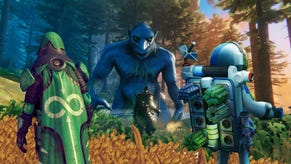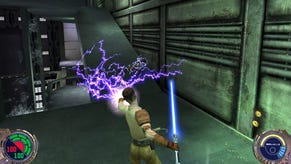Premature Evaluation: Oxygen Not Included
Urine trouble
Every week we warp Brendan into the gaseous caverns of early access to see if he can find precious games worth playing in the gloom. This time, the subterranean space colonisation of Oxygen Not Included [official site]
Everything is covered in piss. When I branded my new space colony ‘Yellow Water Station’ I did so because I was prompted to come up with a suitable name for a settlement on the interstellar frontier. But all I could think of was how weird it is that astronauts drink their own recycled and purified urine. ‘Yellow Water Station’ was my puerile attempt at humour. I didn’t expect the new underground village I was building to accept its new moniker with such enthusiasm. Now everything is covered in piss, poisonous red gas is building up in the sleeping quarters, and there’s a dead body at the bottom of one of the aquifers.
Oxygen Not Included is a management game from Klei, the people who made Don’t Starve and Invisible Inc. It’s best thought of as a cartoony galactic disaster waiting to happen. Much is done in the style of Rimworld but viewed from a side-on angle. Everything happens below the surface of a distant planet, or possibly an asteroid (at least, I didn’t reach any surface during my upward digging). Three chums are warped in to build and get the party started. As the ‘cycles’ pass more chums will come through the warp gate, which gives you a choice out of three people for the colony. CRUCIALLY, the game allows you to rename all of your colonists. The founders of Yellow Water Station, for example, were a narcoleptic technician called Bumpo Bilgetank, a mediocre chef known as Fran Flan Pan, and Doctor Kill, a yokel physician.
They went about their early days as best as I could manage them. They carved out a home and made a latrine in a separate chamber. They made a food machine that turns dirt and water into horrible green bars of mush that come slowly out of the machine’s orifice when someone turns a crank. To power this source of food they built a battery. But to charge the battery one of them has to physically run inside a generator wheel, like a sad rodent. Bumpo Bilgetank was the technician and therefore the most qualified to periodically run like a hamster for several hours of the day.
After some time they were joined by a miner with a fabulous perm called Digmeister Jones. He made sterling work of a flooded passage by digging while completely submerged in water. He would hold his breath, dig, then escape for air, then go back under for more digging.
Eventually, the water dropped away into a new chamber, already formed by the randomly-generated landscaped. “This,” I thought triumphantly, “shall be our sleeping den!” Within four days we had blocked up the chamber again. It had filled with carbon dioxide. Digmeister Jones slept now on the floor of the latrine.
Like in many periods of my life, gas is a big issue. Here, the game simulates the passage of gases around your colony’s chambers. Light gases float, heavy gases sink, they all mix and wander in whatever way science dictates and you can view them more easily on a special screen (see below). When you first warp in, there are some rocks that magically produce oxygen. But those dissolve quite quickly, meaning you’ve got to build machines and research new methods of making the underground air breathable. The colonists at Yellow Water set up two large machines that would turn algae (found on the walls of caverns and buried among the rock) into sweet, sweet O2. Later, we would turn to more ambitious methods of oxygen-producing.
Suffice to say, the bulk of the appeal here is in trying to manage all the different gases (and liquids) that plague your colonists. Carbon dioxide, hydrogen, contaminated oxygen – all of them are a threat in some way and you will have to research new tools and constructions to deal with them. Gas pipes, pressure valves, air filters, generators, vents, airlocks. You’ll be building all of these in a vainglorious attempt to finally tame mankind’s greatest nemesis – air itself. You might succeed. The people of Yellow Water did not.
The team built new beds in an upper chamber following the loss of the lower chamber, which would remain a forbidden zone for the rest of my time as a space manager. They made enough cots for themselves and some new recruits that had warped into the caverns in the meantime. But this room too was becoming stifled. I needed more oxygen production. I turned to the glory of a machine called an electrolyzer, which we dipped into the surface of the water and powered with a separate battery and hamster wheel.
It worked! Precious oxygen was pumping out of it and making the bed chambers slowly more comfortable. But then I saw the other by-product. Hydrogen.
The red gas rose, lighter than the oxygen, and got trapped in pockets in the ceiling. I had an idea. I quickly ordered the colony to dig a tunnel, slightly upwards, into another off-site chamber, where the hydrogen could flow. But this could only be a stopgap. The electrolyzer didn’t produce its gases constantly (only when the air pressure of the surroundings deemed it possible) but it did now and again splutter enough hydrogen into existence to become a growing concern. Meanwhile, by the warp gate, Digmeister Jones couldn’t reach the toilet in time and wet himself in front of two of the colony’s newest recruits.
These problems, both the red gas slowly building up in a rocky pocket and the hot urine dripping down into the kitchen, were a sign of things to come.
But what we needed more urgently, I thought, was a means of dealing with carbon dioxide. A machine that could magically remove it from the air was still too far off on my research tree. But browsing the available options I fancied that I discovered a much better solution. I was going to create a slime farm.
You see, at this point I had the tech to create a bio distillery, which would convert slime (mined from the walls like any other ‘block’) into algae. With that I could create algae mounds – these look like heaps of compost but instead of creating fertilizer they slowly convert CO2 into oxygen. Don’t worry about the details, just know that I did the maths. Fifteen algae pots will produce as much oxygen as one of the electrical O2 machines I currently have hooked up. But, significantly, each algae pile will not use electricity and once they are all combined they will consume less than half of the algae a machine would over the same time. Sustainability, ho!
We got digging. I say "we". I mean I ordered everyone else to dig. Once the slime farm was complete, I would be able to decommission the electrolyzer and put a stop to its treasonous red gas. A relief, because right now I am continually distracted from my tasks in order to build new chambers to where the hydrogen can freely flow. Eventually, the plan is to disassemble the electrolyzer, trap the hydrogen behind an airlock, and then simply forget all about the pocket of dangerous highly explosive gas. I’ll put up a do not enter sign. It’ll be fine.
But it is easier to say “slime farm” than to make “slime farm” a reality. The bio distillery – the integral piece of equipment to the whole endeavour - needed more room than I thought, and also produced waste water that was contaminated. In an attempt to pump this contaminant into a nearby aquifer that was already green with toxicity, I ordered the chums to breach the intervening rock wall and install an outlet pipe as quickly as possible. The runoff would flow into a separate ditch, where it would be caught and contained. Then the wall and ditch would both be plugged again. It would last only a few minutes, I reasoned. That won’t do much harm. Here is a picture of Fergus Fungusmeyer and Doctor Kill waist deep in filthy water, installing the drain pipe.
As you can see, Doctor Kill has become infected with “The Spores”. Don’t worry, he’ll recover. Much worse is the effect opening this toxic gap has had on the air quality of the colony. Every chamber is soon filled with contaminated air. Everyone spends the next handful of days choking on a green miasma.
Even as they sleep, the stink pervades everything and spreads disease with it. Fran Flan Pan is the only one awake tonight. She needs the toilet but it is too full of human waste and she needs to plunge it. Life is terrible here. Why does anyone agree to come to Yellow Water?
The miasma eventually faded after I installed some air purifiers all over the place. The slime farm also became functional but I had only built fifteen of the thirty algae piles I wanted. I considered decommissioning the electrolyzer now. But as I again browsed the new technology we’d been developing a new idea came storming ferociously into my head.
"What if we made this hydrogen generator?"
And lo, it came to pass that the colony got its most powerful electrical generator yet. It took me a good amount of time to figure out the intake pipes, output pipes, air filters, vents, and pressure valves required to piece it all together. But by the end we had a great source of ‘leccy. All it needed was the hydrogen from below to rise. And because of the way I had wired it, it only needed a person to come and spin the wheel to get it started. As long as the hydrogen kept flowing, it could run without human intervention indefinitely. A bigger version of the battery was keeping the energy stored and, as good levels of clean oxygen flowed among the populous, life in Yellow Water seemed, for a moment, to be good.
Then, the slime crisis. The bio distillery ran out of slime. One by one, the algae piles dried up. Oxygen levels would soon be dropping to dangerous levels. I ordered the colony, now numbering a hearty eleven people, to dig for more slime.
But the slime crisis was accompanied by the hydrogen crisis. A venting mistake (whoops) had caused huge amount of hydrogen to leak into the sleeping quarters. To make matters more unstable, the hydrogen crisis preceded the most troubling thing to happen to Yellow Water yet. The great piss crisis.
Sure, it’s possible we could have avoided the great piss crisis of cycle 30. Critics may suggest that installing more than a single functional toilet for eleven people would have been a good first step. Reducing stress by decorating the place or providing massage tables might also have helped. Providing the colony with more than one tiny lamp probably would have allowed people to navigate the settlement more happily and more easily, without say, wading through an ankle deep puddle of human urine. But those critics were not there. They know nothing of the demands of managing a space colony. It was very difficult that cycle and in the subsequent cycles. I had to order a lot of mopping up.
Sadly, the mopping was doing little to stop the failure of the colony. All these crises culminated and Yellow Water soon descended into absolute piss carnage. Stress levels among the colonists sky-rocketed and a man called Grub began to vomit from the anxiety of living in such a stinking yellow hell. Snores O’Duggan, a man who slept apart from everyone else because he snored so loudly that it kept the others awake all night, began to destroy batteries throughout the colony in a blind rage, systematically disabling filters, air pumps, the distillery and the mush machine. Even in the dark and quiet nights, piss dripped down from the sleeping quarters, going from level to level before finally getting into the water supply.
Bumpo Bilgetank was the first casualty of those terrible times. He died while I wasn’t looking. I don't know anything about it. But it seems that as I made busy decisions with pipes and the mop, he had been digging for much-needed slime and had fallen into a deep pit of contaminated water, where he subsequently drowned. He fell from a great height, perhaps slipping on the cocktail of urine and vomit that had accumulated at the mouth of the pit. Whatever the case, Yellow Water had suffered its first loss. One of the original founders had died. At the time of his death, said the game, he had been furious with stress.
That’s when I left Yellow Water Station. A manager can’t be expected to fix everyone’s problems. Critics (damned critics!) might say this is the height of irresponsibility and that at the very least I should see out the development of the new latrines I started. Or that I should take urgent note of the food shortage that was quickly developing. Or that I ought to explore more of the research tree, with its refrigerators and showers and liquid filters and new-fangled overhead lights. But those critics don’t have deadlines to meet. I’ve got other things to do!
Yet I’m sure, given the systems and silliness already on offer in Oxygen Not Included, that other space managers can and will be found. It doesn't quite have personality and drama on par with Rimworld's pawns and emergencies but it is certainly on the right track. Anyone who fancies some disgusting, gas-based lunacy will find something to like about the cartoon caverns here. As for me, I’m done taking the piss.
Oxygen Not Included is out on Alpha on Steam for £14.99/$19.99. These impressions were based on build 1666550





































